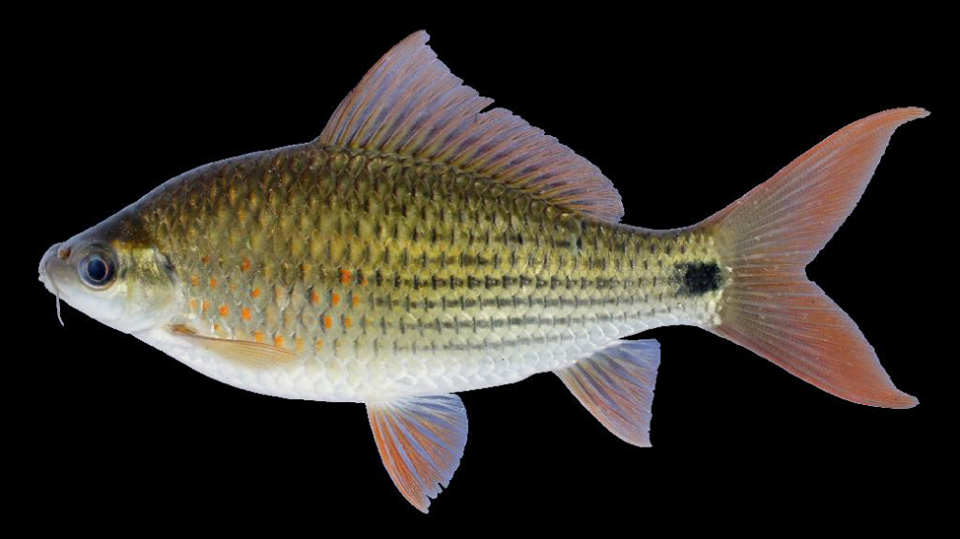by Chhut Chheana – USAID Wonders of the Mekong
The Wonders of the Mekong Project would like to introduce to you a type of freshwater fish that exists in Asia and inhabits the Mekong River, Chao Praya River, Malay Peninsula, Sumatra Island, Java Island, Borneo, Salween River in Myanmar, the Maeklong Basin in Thailand and China.
The bonylip barb, which has the scientific name Osteochilus vittatus, has a standard maximum body length of 32 cm and average standard body length of 20 cm. Adult bonylip barbs live in all type of habitats, but usually inhabit Tonle Sap Lake, river, streams, or canals with slow current and muddy to sandy substrate. They migrate from rivers to floodplain areas during the onset of the flooding season and return to river habitats at the end of that period. Juveniles are usually seen first in August, then move back to permanent water as floodplains dry up.
Characteristics: These fish have 17 to 19 dorsal soft rays and 8 anal soft rays. They can be distinguished from the other species of the genus by their 12-18 branched dorsal rays; 6-9 rows of spots along their scale rows, and a large round blotch on the caudal peduncle. They don’t have a black mid-lateral stripe, and sometimes there is a spot above their pectoral fin. Bonylip barbs feed on unicellular algae, some crustaceans, plankton, and earthworms.
Please protect our flooded forest, which is the fisheries spawning ground, and eradicate the use of illegal fishing gears which is prohibited by law. This protection can restore the abundance of fish for our next generation.

Bonylip barb photo credit: Mohd Shalahuddin Adnan – ffish.asia
ត្រីក្រុសម៉េម៉ាយ – ដោយ៖ ឈុត ឈាណា / USAID Wonders of the Mekong
គម្រោងអច្ឆរិយភាពនៃទន្លេមេគង្គ (Wonders of the Mekong) សូមណែនាំត្រីមានស្រកាមួយប្រភេទ ដែលជាប្រភេទត្រីទឹកសាប មានរស់នៅក្នុងទ្វីបអាស៊ី នៅក្នុងទន្លេមេគង្គ និងទន្លេចៅប្រាយ៉ា ឧបទ្វីបម៉ាឡេ កោះស៊ូម៉ាត្រា កោះជ្វា បូណេអូ ទន្លេសាល់វីន ក្នុងប្រភេទមីយ៉ាន់ម៉ា ទន្លេមេខ្លងក្នុងប្រទេសថៃ និងនៅក្នុងប្រភេទចិន។
ត្រីក្រុសមេម៉ាយ មានឈ្មោះវិទ្យាសាស្ត្រ (Osteochilus vittatus) និងឈ្មោះជាភាសាអង់គ្លេស Bonylip barb មានស្តង់ដាប្រវែងដងខ្លួនអតិបរមាសរុប ៣២ ស.ម និងស្តង់ដាប្រវែងដងខ្លួន ទូទៅ ២០ ស.ម។ ត្រីក្រុសមេម៉ាយពេញវ័យ រស់នៅក្នុងទីជម្រកគ្រប់ប្រភេទ ប៉ុន្តែ ជាទូទៅនៅក្នុងបឹងទន្លេសាប ទន្លេ ស្ទឹង ព្រែក ដែលមានទឹកហូរយឺតៗ និងនៅស្រទាប់បាតក្រោមមានភក់ ខ្សាច់។ វាធ្វើចរាចរផ្លាស់ទីចេញពីទន្លេចូលទៅក្នុងតំបន់វាលទំនាបលិចទឹក អំឡុងពេលទឹកជំនន់ និងត្រឡប់ចូលទៅទីជម្រកក្នុងទន្លេវិញ នៅចុងរដូវទឹកជំនន់។ ត្រីក្រុសមេម៉ាយជំទង់ ជាទូទៅឃើញមានជាលើកដំបូងនៅក្នុងខែសីហា ពួកវាវិលត្រឡប់ចូលទៅទីជម្រកដើមវិញ ខណៈតាមតំបន់វាលទំនាបលិចទឹករីងហួត។
លក្ខណៈសម្គាល់៖ មានព្រុយទ្រនុងខ្នងទន់ចំនួន ១៧-១៩ទ្រនុង។ ព្រុយទន់នៅគូទ មានចំនួន៨ ទ្រនុង។ ខុសប្លែកពីត្រីផ្សេងទៀត ដែលស្ថិតនៅក្នុងពួកតែមួយ ព្រុយខ្នងរបស់ត្រីក្រុសមេម៉ាយ មានចំនួន ១២-១៨ ទ្រនុង មានស្នាមអុតខ្មៅចំនួន ៦-៩ ជួរ នៅតាមបណ្តោយជួរស្រកា និងមានស្នាមអុតខ្មៅធំមួយទៅក្បែរគល់កន្ទុយ។ វាគ្មានខ្សែឆ្នូតនៅជំហៀងដងខ្លួនឡើយ។ ជួនកាលមានចំណុចខ្មៅមួយនៅខាងលើព្រុយទ្រូង។ ត្រីក្រុសមេម៉ាយ ស៊ីស្លែ កម្ទេចកម្ទី ប្លង់តុងរុក្ខជាតិ ប្លង់តុងសត្វ និងជន្លេនជាអាហារ។
សូមចូលរួមជួយថែរក្សាព្រៃលិចទឹក ដែលជាជម្រកពងកូនរបស់មច្ឆជាតិ ឲ្យបានគង់វង្ស និងជួយលប់បំបាត់រាល់ការប្រើប្រាស់ឧបករណ៍នេសាទដែលច្បាប់ហាមគាត់គ្រប់ប្រភេទ ប្រយោជន៍ដើម្បីឲ្យត្រីគ្រប់ប្រភេទសម្បូរឡើងវិញ សម្រាប់ទុកឲ្យកូនចៅយើងជំនាន់ក្រោយ។
ត្រីក្រុសមេម៉ាយ។ រូបភាព៖ Mohd Shalahuddin Adnan / ffish.asia